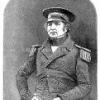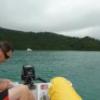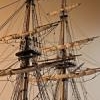
wq3296
-
Posts
350 -
Joined
-
Last visited
Reputation Activity
-
 wq3296 got a reaction from Erebus and Terror in THE BLACKEN-IT TRIALS
wq3296 got a reaction from Erebus and Terror in THE BLACKEN-IT TRIALS
Greetings E&T,
With all due respect to your exhaustive experimentation, you lost me. As your final step, you sprayed the parts with a flat finish. I think you could have achieved the same result by using flat black spray paint directly on the brass and avoided all the extra work and expense. One of the posts mentioned using steel instead of brass which, in my opinion, makes more sense for pintles and gudgeons and other parts. These items were originally made of wrought iron which would have oxidized through any coating applied to them. Accordingly, steel would mimic iron in that it would start out grey and age to a light rust color, possibly eliminating the need for blackening.
Don't misunderstand - your work was instructive, but I don't think the result of your method justifies the effort involved: particularly when you suggest coating it with a finish anyway. wq3296
-
 wq3296 got a reaction from riverboat in Schooner plank length
wq3296 got a reaction from riverboat in Schooner plank length
Greetings Frank,
According to the book entitled A shipyard in Maine (about schooners built by Percy and Small between 1894 and 1920) planks up to 45' long were used to construct their schooners. All this proves is that builders used whatever was readily available and easy to work with. As to your build, I can't see how you could be wrong so long as you use a plank of reasonable length (12' to 20' or more) and, more importantly, follow the rules regarding joint placement.
wq3296
-
 wq3296 got a reaction from dgbot in Schooner plank length
wq3296 got a reaction from dgbot in Schooner plank length
Greetings Frank,
According to the book entitled A shipyard in Maine (about schooners built by Percy and Small between 1894 and 1920) planks up to 45' long were used to construct their schooners. All this proves is that builders used whatever was readily available and easy to work with. As to your build, I can't see how you could be wrong so long as you use a plank of reasonable length (12' to 20' or more) and, more importantly, follow the rules regarding joint placement.
wq3296
-
 wq3296 got a reaction from popeye2sea in Super Ship Constitution
wq3296 got a reaction from popeye2sea in Super Ship Constitution
Henry,
I agree - nothing really new about a Bugatti Veyron, but when you put all the best concepts together into an integrated package, you get something special. I expect that she and her sisters were miles ahead of anything from the Europe.
Rich,
If you need another good reference, see A Most Fortunate Ship by Tyrone G. Martin. Also, there is a wealth of information on the Constitution Museum web site. It might help if you need to know the colors of the actual ship.
wq3296
-
 wq3296 got a reaction from michaelpsutton2 in Super Ship Constitution
wq3296 got a reaction from michaelpsutton2 in Super Ship Constitution
Greetings,
Disclaimer: I am not an authority, and my opinion is based on books written by others.
The Constitution and her sister ships seem to represent the epitome of frigate design for that era - late 18th century into the 19th century. These so called heavy frigates blended speed, fire power, strength, and seaworthyness into a very potent fighting platform. I expect they could punch well above their weight class. Further, the Constitution probably would have been a match for ships even above her rating if handled well. I expect her speed would have given her an advantage over plodding 74s, and maybe some first rates, even with a deficit in metal through weight.
wq3296
-
 wq3296 got a reaction from trippwj in Super Ship Constitution
wq3296 got a reaction from trippwj in Super Ship Constitution
Greetings USS...
Agree on the guns, but not on the ship design. Humphreys's hull designs for these six heavy frigates were absolutely innovative. Diagonal hull riders, wider and stronger gangways to create a spar deck suitable to handle heavy guns, tight spacing between pairs of frames (2"), new construction methods, etc. were all unique features credited to Humphreys.
I am not surprised that a heavy French frigate could take out a 74. If they were anywhere near as fast as the Constitution they could control a battle.
wq3296
-
 wq3296 got a reaction from trippwj in Super Ship Constitution
wq3296 got a reaction from trippwj in Super Ship Constitution
Greetings,
Disclaimer: I am not an authority, and my opinion is based on books written by others.
The Constitution and her sister ships seem to represent the epitome of frigate design for that era - late 18th century into the 19th century. These so called heavy frigates blended speed, fire power, strength, and seaworthyness into a very potent fighting platform. I expect they could punch well above their weight class. Further, the Constitution probably would have been a match for ships even above her rating if handled well. I expect her speed would have given her an advantage over plodding 74s, and maybe some first rates, even with a deficit in metal through weight.
wq3296
-
 wq3296 got a reaction from trippwj in Deck beam Scarphs?
wq3296 got a reaction from trippwj in Deck beam Scarphs?
Greetings Jud,
It is understood that deck beams do more than hold up the decks. In fact, they function as a diaphragm to brace the perimeter of a ship: much the same function as the floor structure in a building.
wq3296
-
 wq3296 got a reaction from jud in Deck beam Scarphs?
wq3296 got a reaction from jud in Deck beam Scarphs?
Folks,
Nice post. From an engineering point of view, I can't see why builders of wooden ships would ever use timbers of that length for deck structure, even if available. No matter how you slice it and dice, intermediate support columns or bearing walls would absolutely be necessary under a very long deck beam because it would deflect a considerable amount just from its own weight. These are the same principals used in building design and construction today. See Longridge's book on the Victory - it looks like a forest below decks for all the columns in place. Accordingly, if columns are required anyway, why not use shorter deck beams designed for a specific acceptable deflection? Shorter beams would be easier to install and readily available. Further, except for the keel and other members that are fully supported, I expect that the scarcity of long timbers was not the reason why they weren't necessarily used for deck sub structure. The requirement for columns necessitated by the live and dead loads associated with sailing ships would over ride the need for super long deck timber, in my opinion. Note that ideally, the scarph joints would be horizontal type centered over column locations where you have minimum moment but maximum shear load, which is resisted by the reaction at the column.
I would suggest you use the scarphed joints and place them at regular intervals. I doubt they were placed randomly, particularly on a 17th century war ship. In some instances where long spans were necessary and columns were not workable, I expect deck beams would have been lapped side by side, with the length of lap made long enough to occur well past the point of maximum moment which would be center span. I am not sure how far structural design had advanced during the 17-18 centuries, but considering some of the cathedrals built during that time, I expect it was fairly advanced and would have extended to ship building.
Note that I am offering what I think are common sense solutions based on time tested engineering principals. Of course, there may be information available that says I'm all wet. However, if you think I'm all wet please provide hard evidence to support your position. Nice topic and thank you for bringing it up. Maybe we can all learn something.
wq3296
-
 wq3296 got a reaction from NMBROOK in Deck beam Scarphs?
wq3296 got a reaction from NMBROOK in Deck beam Scarphs?
Greetings Nigel,
I guess it would depend on how far structural analysis as a practical design tool had progressed during that time period. My sense is that it hadn't progressed enough to where the designers/builders were calculating the placement of columns, knees, etc. This leaves us with "rule of thumb" design. I have read, in one of Chappelle's books I think, that major aspects of ship design was based on proportion. Even spar diameter was related to length of the spar, which was related to overall mast height, which was related to ship LOA, and so on. So, if you knew the LOA of a particular class of ship, you were off to the races and could pretty much design the major dimensions for a new ship. Plus, let's not forget good old design by previous experience - also known as trial and error. A good example of this gone wrong is the Vasa sinking, which I am sure you know about.
As with building design, girders span between columns, and beams span between girders. I guess the ship equivalent would scantlings, pillars, and carlins. You could use a modern timber design manual to arrive at reasonable spans for a given timber cross section based on the wood you are using from the kit. This should range you in close enough for what you want to do. Grog time.
wq3296
-
 wq3296 got a reaction from NMBROOK in Deck beam Scarphs?
wq3296 got a reaction from NMBROOK in Deck beam Scarphs?
Greetings Nigel, Et Al,
Good discussion all around. My thoughts:
Not disputing the information provided because it is reasonable. However, see latest issue of Ships in Scale for the article on L'Hermione, Photo 9, page 17. Photo shows new keel on its side, ready for placement. Note the horizontal scarph. Many other good photos in this article showing her in frame. She's French built.
Now that I've had a chance to think about it, vertical scarphs make perfect sense, particularly for scarphs that are unsupported by a column or other structure. A vertical scarph seems as though it would be better at resisting deflection. The location of the neutral axis would not change because the two full depth beams are apt to act together. With a horizontal scarph, each beam member would have its own neutral axis and may act independently, depending on how they were fastened. For supported scarph joints, it probably doesn't matter because the support would take the load.
In Longridge's book, he has a section on scarphs and reports that, on British ships, the keels had vertical scarphs but keelsons had horizontal scarph. Our discussion here is about deck beams, but I guess the type of scarph used by different builders for various applications was subjective.
Thank you all for a good discussion from which I benefited. What's next?
wq3296
-
 wq3296 got a reaction from james c lusk in plank entire second layer length with one strip?
wq3296 got a reaction from james c lusk in plank entire second layer length with one strip?
Greetings,
Either way, but if you plank with scale plank lengths, make sure you follow the planking protocol regarding butt spacing. Since you will be planking over the first layer, you won't have to worry about butt blocks for butts that don't land on framing. Also, I never bother with trying to simulate trunnels in decks or hull planking, or dimpling copper sheathing because the scale never works and the end result is not worth the effort, in my opinion.
wq3296
-
 wq3296 got a reaction from trippwj in Deck beam Scarphs?
wq3296 got a reaction from trippwj in Deck beam Scarphs?
Folks,
Nice post. From an engineering point of view, I can't see why builders of wooden ships would ever use timbers of that length for deck structure, even if available. No matter how you slice it and dice, intermediate support columns or bearing walls would absolutely be necessary under a very long deck beam because it would deflect a considerable amount just from its own weight. These are the same principals used in building design and construction today. See Longridge's book on the Victory - it looks like a forest below decks for all the columns in place. Accordingly, if columns are required anyway, why not use shorter deck beams designed for a specific acceptable deflection? Shorter beams would be easier to install and readily available. Further, except for the keel and other members that are fully supported, I expect that the scarcity of long timbers was not the reason why they weren't necessarily used for deck sub structure. The requirement for columns necessitated by the live and dead loads associated with sailing ships would over ride the need for super long deck timber, in my opinion. Note that ideally, the scarph joints would be horizontal type centered over column locations where you have minimum moment but maximum shear load, which is resisted by the reaction at the column.
I would suggest you use the scarphed joints and place them at regular intervals. I doubt they were placed randomly, particularly on a 17th century war ship. In some instances where long spans were necessary and columns were not workable, I expect deck beams would have been lapped side by side, with the length of lap made long enough to occur well past the point of maximum moment which would be center span. I am not sure how far structural design had advanced during the 17-18 centuries, but considering some of the cathedrals built during that time, I expect it was fairly advanced and would have extended to ship building.
Note that I am offering what I think are common sense solutions based on time tested engineering principals. Of course, there may be information available that says I'm all wet. However, if you think I'm all wet please provide hard evidence to support your position. Nice topic and thank you for bringing it up. Maybe we can all learn something.
wq3296
-
 wq3296 got a reaction from Landlubber Mike in HMS Lyme (1748-1760) by Landlubber Mike - bash of Corel Unicorn - Scale 1:75 (CLOSED TO START SCRATCH BUILD)
wq3296 got a reaction from Landlubber Mike in HMS Lyme (1748-1760) by Landlubber Mike - bash of Corel Unicorn - Scale 1:75 (CLOSED TO START SCRATCH BUILD)
Greetings Mike,
I like your approach to model building. Yes, by all means paint with wood and don't be afraid to change the kit when historical data and common sense dictate a different approach. You are wise to consult historical data because, in my opinion, it trumps the kit plans. Even subtle changes to make the model period correct will ensure that yours will stand out from the crowd. To me, being as period correct as possible is the essence of a ship model. I have built two Corel kits: Endeavor and the Berlin. I think Corel is a great product.
I built the Morgan several years ago. It may be more of a challenge than the Unicorn since it is single plank basswood and many of the components have to be built from from scratch. You will note that the Morgan plans call for several different strip widths for hull planking.
wq3296
-
 wq3296 got a reaction from Bindy in Why do hot guns jump violently?
wq3296 got a reaction from Bindy in Why do hot guns jump violently?
Greetings Folks,
Excellent topic and discussion. - many good guesses. Physics are physics. Hot barrel with ambient temperature shot equals more clearance around shot resulting in more blow by. Accordingly, there would be less power applied to the shot and, therefore, less recoil force. Think of your first BB gun. When the piston dried out its diameter reduced and there was less force to drive the BB.
Relative to brass guns producing more recoil (or violent jumping) than iron, you have to consider the facts. For a given shot size, what was the relative weight of the respective guns? Of course, gun weight has a bearing on recoil. I am a gun enthusiast, and my .357 revolver kicks much more than my .357 rifle using the same cartridge because the rifle weighs more. As far as the guns changing physical properties when hot, this is plausible up to a point. If you fire a gun long enough, the barrel will distort causing the center line of the barrel to deviate up, down, left or right, resulting in the thrust of the shot (or round) not being directed straight back. I think this could cause a jump instead of a linear push back. I expect that the guns could have been fired to the point of distortion. Although, the barrels would probably have been ruined because they would taken a set after cooling and would not be able to fire straight again. Early machine guns were water cooled to prevent overheating. However, the barrels still needed replacement after a time.
I expect that increased gun recoil when hot is a fact, but I think it would relate to barrel center line distortion. The fact that this problem still exists today is a good indicator that it could be responsible for the old accounts of jumping guns.
wq3296
-
 wq3296 got a reaction from dafi in Why do hot guns jump violently?
wq3296 got a reaction from dafi in Why do hot guns jump violently?
Greetings Folks,
Excellent topic and discussion. - many good guesses. Physics are physics. Hot barrel with ambient temperature shot equals more clearance around shot resulting in more blow by. Accordingly, there would be less power applied to the shot and, therefore, less recoil force. Think of your first BB gun. When the piston dried out its diameter reduced and there was less force to drive the BB.
Relative to brass guns producing more recoil (or violent jumping) than iron, you have to consider the facts. For a given shot size, what was the relative weight of the respective guns? Of course, gun weight has a bearing on recoil. I am a gun enthusiast, and my .357 revolver kicks much more than my .357 rifle using the same cartridge because the rifle weighs more. As far as the guns changing physical properties when hot, this is plausible up to a point. If you fire a gun long enough, the barrel will distort causing the center line of the barrel to deviate up, down, left or right, resulting in the thrust of the shot (or round) not being directed straight back. I think this could cause a jump instead of a linear push back. I expect that the guns could have been fired to the point of distortion. Although, the barrels would probably have been ruined because they would taken a set after cooling and would not be able to fire straight again. Early machine guns were water cooled to prevent overheating. However, the barrels still needed replacement after a time.
I expect that increased gun recoil when hot is a fact, but I think it would relate to barrel center line distortion. The fact that this problem still exists today is a good indicator that it could be responsible for the old accounts of jumping guns.
wq3296
-
 wq3296 got a reaction from WackoWolf in plank on frame
wq3296 got a reaction from WackoWolf in plank on frame
Greetings Andy,
See Jefferson Davis kit by BlueJacket Ship Crafters, Item #K1051. This kit is a true plank on frame model. All of the frames are pre cut, requiring only sanding and filing to finish them to final shape and size. Go to website www.bluejacketinc.com. This company is based in Seaport, Maine in the USA. I know you are looking for a UK kit, but am unaware if similar kits are available in UK. The advantage to this plank on frame kit is that you will not have to purchase power tools to build.
The model is of a Baltimore Clipper, which is a square topsail schooner. You can leave the planking off some, or all, of the hull to show frames Admiralty style. I built this exact model a few years ago and was extremely please with it. BlueJacket is an excellent model manufacturer. I have built several of their kits. Note that they also make a plank on frame model of the Yacht America, Item #K1050.
wq3296
-
 wq3296 got a reaction from @macbride in Soaking, bending, gluing planks
wq3296 got a reaction from @macbride in Soaking, bending, gluing planks
Greetings Andy,
In my opinion, forget the jigs and other stuff they sell in hobby stores to bend planks. I use steam. You probably have a tea kettle, so just bring some water to a boil, hold the plank near the spout when it begins to steam and gently form the plank to the desired shape by hand. You may even be able to slide the plank down the spout as it softens from the steam. Of course, the steam is hot so use caution. I came across an electric heating iron used to glue seams for carpeting. It is shaped similar to a flat iron, but is much smaller. It is far better than the electric plank benders sold in hobby stores and is not made in China.
wq3296
-
 wq3296 got a reaction from Ferit in Frigate Berlin by Ferit KUTLU - Corel - 1/40 - 1674
wq3296 got a reaction from Ferit in Frigate Berlin by Ferit KUTLU - Corel - 1/40 - 1674
Greetings Ferit,
I built this model a few years ago, and it is one of my favorites. In my opinion, Corel is one of the better European models on the market, which explains their higher cost. You are doing a fine job. I like the way you formed the whip staff. I am sure you know that the whip staff was used to steer ships prior to the wheeled helm. Many opportunities to scratch build sub assemblies on this model. I did some carving on the prow since it is quite large.
wq3296
-
 wq3296 got a reaction from ortho85 in Edge bending planks
wq3296 got a reaction from ortho85 in Edge bending planks
Greetings Brett,
1. If wider sheet stock is not available, you could edge glue some strips together and cut the plank you need from it. Careful fitting and sanding should hide the glue joint.
2. The difficulties associated with edge bending in the construction of real ships were mitigated by spiling and carving required shapes from balks of solid wood - same methods modelers use. Spiling involves measuring and cutting a plank to a specific shape to fill in an odd shape between standard planks, keel, etc.
wq3296
-
 wq3296 got a reaction from trippwj in US Frigate Essex by trippwj - Aeropiccola - 1:70 Scale - POB
wq3296 got a reaction from trippwj in US Frigate Essex by trippwj - Aeropiccola - 1:70 Scale - POB
Greetings Wayne,
What you have there is plywood being plywood. Clamping, wetting, voodoo, etc. will not work unless you remove the stress in the tension side of the plywood. The usual methods can sometimes work with solid wood because the grain is consistent all the way through. However, plywood is made up of multiple layers - each with a different grain. What I am about to describe has worked for me: First, I would cut those tie rods loose between the affected frames. You don't have to take them out, just remove an 1/8" or so from the centers so the keel can move. Next, cut vertical scores into, or through if necessary, the outer plys of the keel on both sides of the bend. Then bend the keel as appropriate to remove the bend. While bending, you may actually crack the inner keel plys somewhat, but that is the only way you will remove the bend. When she's all nice and straight, glue some fish plates over the scores to restore stiffness. You may also need to loosen some of the frames in the area to make sure the keel can be bent enough to straighten it. You can use a hacksaw blade to do this work.
This will work - I can't see how you could possible fill the keel enough to eliminate the bend without screwing up the geometry of the hull in the affected area. wq3296
-
 wq3296 got a reaction from WackoWolf in Edge bending planks
wq3296 got a reaction from WackoWolf in Edge bending planks
Greetings Ortho...
I generally agree with Allan and my apparent fellow Rhode Islander. It is not natural for wood strips to edge bend because the compression side bunches up and the tension side stretches and wants to pull apart. One solution is to cut small scores (or pie shapes) on the compression side so the compressed wood has a place to go. The scores should extend at least to the middle of the strip, through the neutral axis. If done carefully, this will work but the scores may show if the part is to be left unpainted. Another method I have used, particularly at the bow, is to laminate three or four square section strips of wood together since the square strips bend easily. I do this in place, one strip at a time until the the desired width is achieved.With sanding, the seems will all but disappear if the strips lay together tightly. You can use the same method almost anywhere. Keep in mind that the planking strips supplied with model kits can be out of scale so you could split them in half for an easier bend and still be correct scale wise, especially on a transom. However, it is easier to carve (spile) an oversize plank than to fight with edge bending. wq3296
-
 wq3296 got a reaction from KenW in US Frigate Essex by trippwj - Aeropiccola - 1:70 Scale - POB
wq3296 got a reaction from KenW in US Frigate Essex by trippwj - Aeropiccola - 1:70 Scale - POB
Greetings Wayne,
What you have there is plywood being plywood. Clamping, wetting, voodoo, etc. will not work unless you remove the stress in the tension side of the plywood. The usual methods can sometimes work with solid wood because the grain is consistent all the way through. However, plywood is made up of multiple layers - each with a different grain. What I am about to describe has worked for me: First, I would cut those tie rods loose between the affected frames. You don't have to take them out, just remove an 1/8" or so from the centers so the keel can move. Next, cut vertical scores into, or through if necessary, the outer plys of the keel on both sides of the bend. Then bend the keel as appropriate to remove the bend. While bending, you may actually crack the inner keel plys somewhat, but that is the only way you will remove the bend. When she's all nice and straight, glue some fish plates over the scores to restore stiffness. You may also need to loosen some of the frames in the area to make sure the keel can be bent enough to straighten it. You can use a hacksaw blade to do this work.
This will work - I can't see how you could possible fill the keel enough to eliminate the bend without screwing up the geometry of the hull in the affected area. wq3296
-
 wq3296 got a reaction from rafine in Fair American by GaryKap - FINISHED - Model Shipways - Scale 1:48
wq3296 got a reaction from rafine in Fair American by GaryKap - FINISHED - Model Shipways - Scale 1:48
Greetings Gary,
I understand and appreciate your method. However, from a practical point of view, you won't know if it was worth the effort until you start laying up the planks. No matter how you slice it and dice it, each and every plank will be different due to variables that you cannot foresee. You will need to "cut and try" each plank anyway, and if you take too much off as you mass produce the planks... I would feel more comfortable with your doing 2-3 planks at a time instead of 7-8, and then installing them to make sure all is well. Frankly, I do one plank at a time - measure, cut, measure again, try it, more fetteling, fit it.
With all that said, I am curious to see how it all comes out. If it works as slickly as you hope, my hat is off to you, and I will have learned something. I expect you will have good success based on your level of effort and attention to detail. It must have taken you some time to do the spread sheet and take all those measurements. Good work. wq3296
















